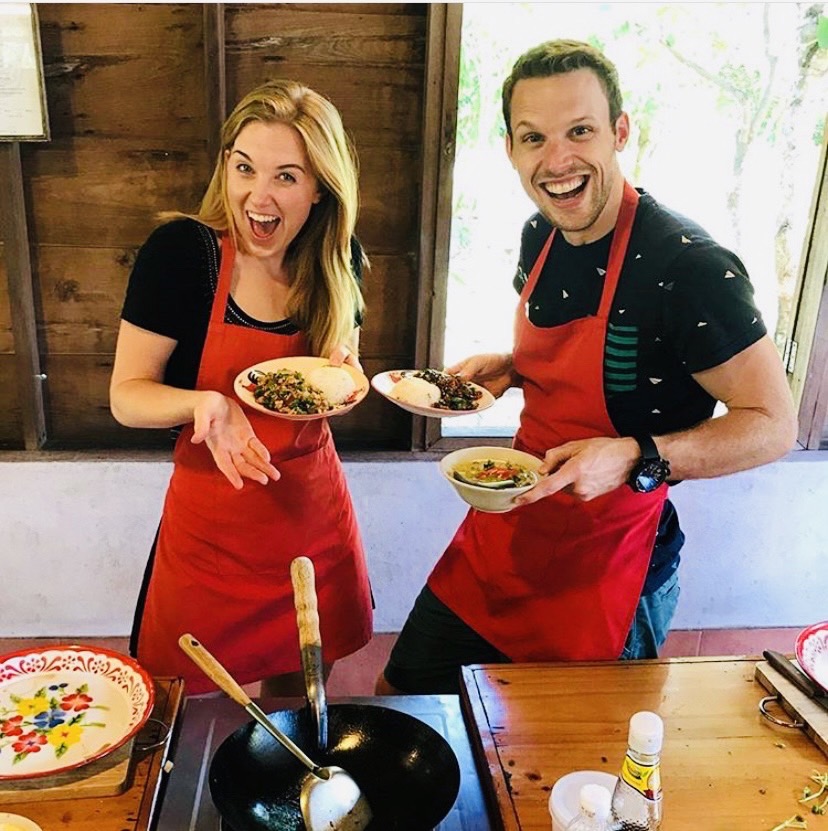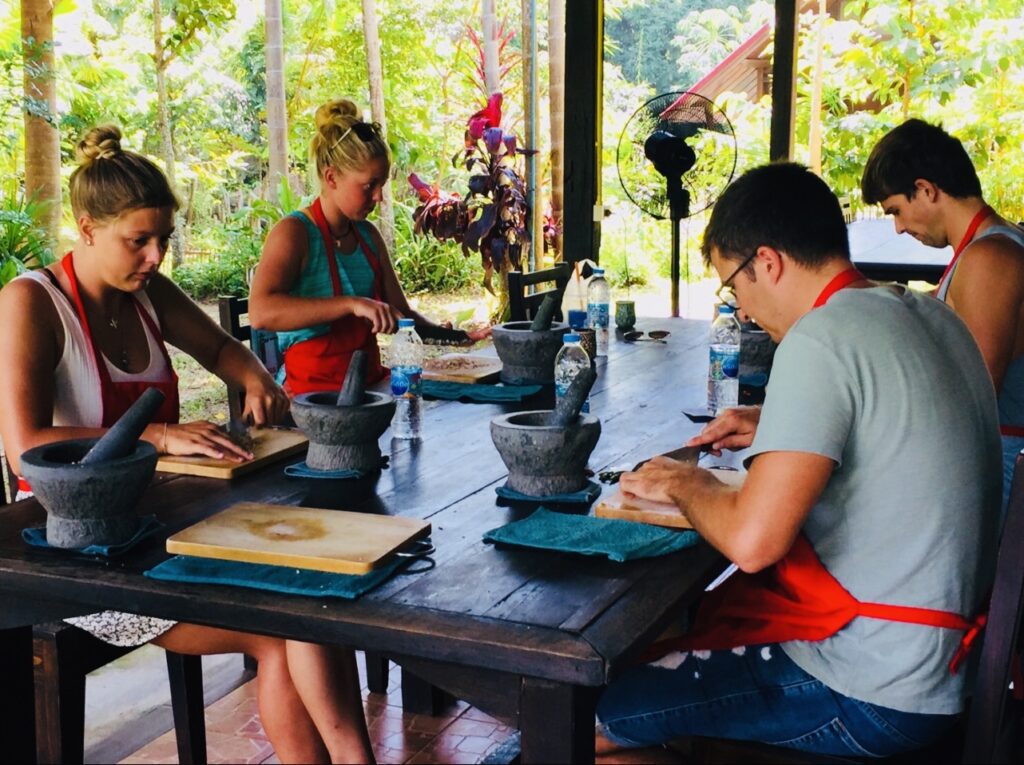


Chiang Mai doesn’t shout like Bangkok or glitter like Phuket. It doesn’t need to. This northern Thai city whispers to the senses — a quiet confidence built on centuries of culture, a cooler mountain breeze, and a culinary scene that’s as rich in flavor as it is in soul. For food lovers, Chiang Mai is a revelation. Not because it offers something flashy, but because it offers everything — depth, authenticity, variety, and surprise.
Street Food That’s Anything But Basic
Start with the streets. Chiang Mai’s night markets are legendary, and for good reason. The moment the sun dips, the stalls come alive. You’ll find grilled meats skewered over charcoal, sticky rice rolled into banana leaves, fiery green papaya salads, and bowls of khao soi — the unofficial king of northern Thai cuisine — all served fast, hot, and cheap.
But cheap doesn’t mean basic. These dishes are built on generations of refinement. The balance of heat, sour, sweet, and umami is no accident — it’s craftsmanship. At the Chang Phuak Gate night market (also called the North Gate), Auntie Fai with her cowboy hat ladles out steaming bowls of braised pork leg over rice. Simple? Yes. But one bite, and you’ll understand why there’s a permanent line.
Khao Soi: Chiang Mai’s Culinary Icon
Every region of Thailand has its signature dishes, and for Chiang Mai, it’s khao soi. A creamy, curry-laced noodle soup with both boiled and crispy egg noodles, this dish is comfort in a bowl. It’s coconut-based but spiced with dried chili, turmeric, and shallots — not too hot, but incredibly warming.
You’ll find khao soi everywhere, from back-alley stalls to upscale restaurants, but the best spots are usually no-frills joints. Khao Soi Mae Sai and Khao Soi Khun Yai are both local institutions. The ritual is always the same: squeeze of lime, pickled mustard greens on the side, spoon in — and sigh.
A Plant-Powered Paradise
Chiang Mai is also a dream for vegetarians and vegans. The Buddhist influence here runs deep, and many locals follow meatless diets during holy periods. As a result, the city is overflowing with plant-based options that go far beyond tofu and salads.
Think mushroom larb (traditionally made with minced pork), banana blossom curry, grilled eggplant with fresh herbs, and jackfruit rendang. Spots like Reform Kafé and Goodsouls Kitchen are just a couple of the city’s beloved vegan eateries — creative, fresh, and completely satisfying.
Markets That Feed the Soul
For food lovers who want to go deeper, Chiang Mai’s markets offer more than ingredients — they offer stories. At Warorot Market, you’ll find everything from preserved fruits and fragrant spices to roasted insects (if you’re feeling bold). It’s not sanitized for tourists. It’s real — vibrant, busy, and unapologetically local.
There’s something visceral about walking through these markets. The scent of lemongrass and chili hangs in the air. Vendors shout prices in melodic Thai. And tucked into every corner, there’s something new to taste, to smell, to learn.
Learn to Cook Like a Local: Thai Farm Cooking School
But eating your way through Chiang Mai is only half the experience. If you really want to connect with the cuisine, you have to cook it. And there’s no better place to do that than the Thai Farm Cooking School.
Unlike urban cooking classes held in cramped kitchens, Thai Farm takes you out of the city and into the lush countryside. You’ll walk through organic gardens, picking fresh ingredients like Thai basil, kaffir lime leaves, and bird’s eye chilies before learning how to turn them into restaurant-worthy dishes.
It’s hands-on, yes, but also deeply personal. The instructors don’t just teach technique — they share the history and soul of each dish. You’ll learn why Thai food is built around balance, how to properly grind a curry paste with a mortar and pestle, and why fresh coconut milk makes all the difference.
By the end, you won’t just leave full — you’ll leave with a new respect for the food, the farmers, and the culture that shaped it.
Coffee, Dessert, and the Slow Food Scene
Chiang Mai also has a quietly growing café culture, especially in the Nimmanhaemin area. Think pour-over coffee, locally grown beans from the northern hills, and minimalist spaces that feel more Kyoto than Bangkok.
Desserts? Try the sticky rice with mango, of course — but also dive into lesser-known treats like tub tim krob (crispy ruby water chestnuts in coconut milk) or khanom krok (grilled coconut pancakes). These aren’t afterthoughts — they’re expressions of local craft, made with care and served with pride.
Beyond the Plate: Food as Connection
What sets Chiang Mai apart isn’t just the variety or the flavor — it’s the feeling. Food here isn’t transactional. It’s emotional. You’re not just ordering dinner — you’re being welcomed into someone’s story, their family, their way of life.
It’s the vendor who remembers how spicy you like your curry.
The grandma who runs the noodle shop and insists you try her mangoes “on the house.” The instructor who tells you her grandmother’s version of tom yum was made without lemongrass — and dares you to try it that way.
In Chiang Mai, food is how people connect. With each other, with the land, with tradition.
For food lovers, Chiang Mai is more than a destination — it’s a classroom, a playground, and a memory that lingers long after the last bite. Whether you’re slurping noodles on a plastic stool or learning to fry spring rolls at Thai Farm Cooking School, every experience brings you closer to the heart of Thailand.
So come hungry. Come curious. Chiang Mai is ready for you.

Pingback: buying androxal generic cheap
Pingback: buy cheap enclomiphene generic canadian
Pingback: how to order rifaximin canada over the counter
Pingback: ordering xifaxan generic uk next day delivery
Pingback: buying staxyn uk online pharmacy
Pingback: discount avodart generic united states
Pingback: how to buy dutasteride uk delivery
Pingback: buy flexeril cyclobenzaprine lowest cost pharmacy
Pingback: buying gabapentin uk online pharmacy
Pingback: online order fildena usa pharmacy
Pingback: best prices on generic itraconazole
Pingback: proč jsou ceny kamagra tak vysoké
Pingback: acheter kamagra sans ordonnance
The animatronics in fnaf 2 are a stressful and unpredictable bunch. The newer, redesigned Toy versions move quickly and react very sensitively to the player’s actions.